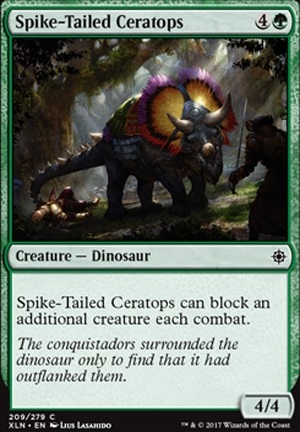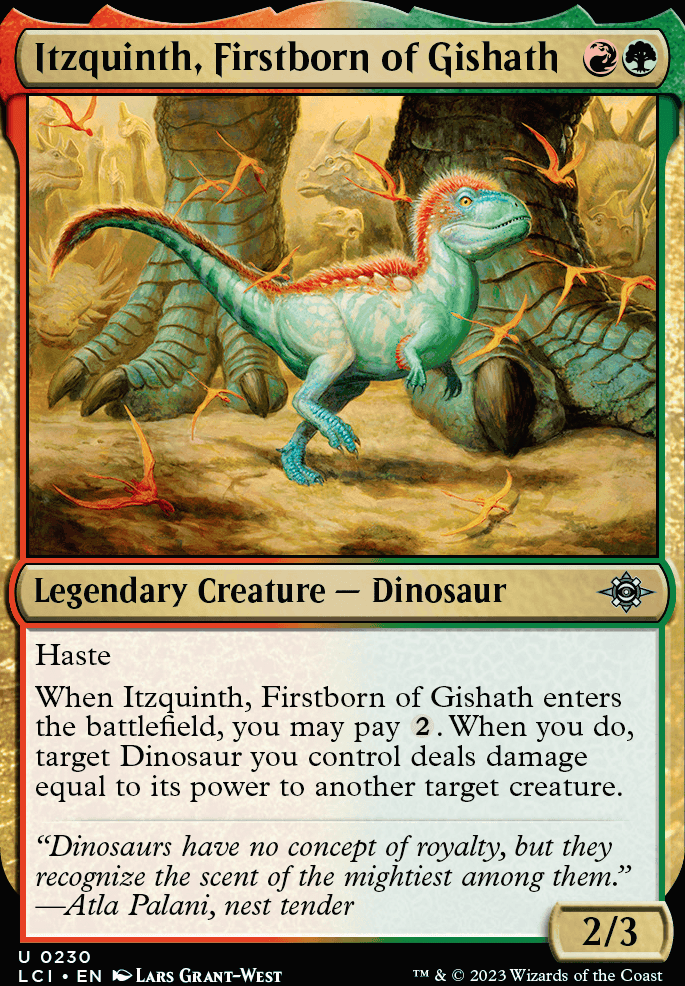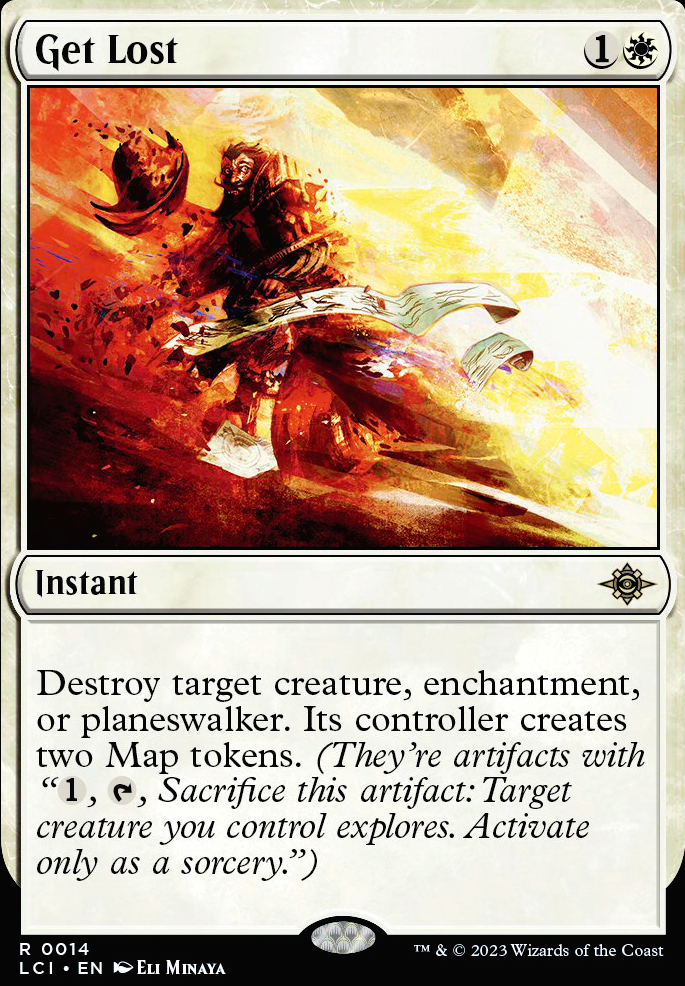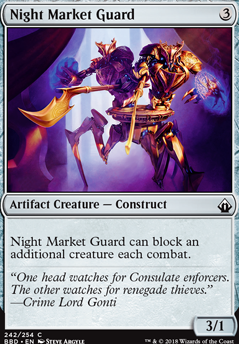
Combos Browse all Suggest
Legality
| Format | Legality |
| 1v1 Commander | Legal |
| Archenemy | Legal |
| Arena | Legal |
| Block Constructed | Legal |
| Canadian Highlander | Legal |
| Casual | Legal |
| Commander / EDH | Legal |
| Commander: Rule 0 | Legal |
| Custom | Legal |
| Duel Commander | Legal |
| Gladiator | Legal |
| Highlander | Legal |
| Historic | Legal |
| Legacy | Legal |
| Leviathan | Legal |
| Limited | Legal |
| Modern | Legal |
| Oathbreaker | Legal |
| Pauper | Legal |
| Pauper Duel Commander | Legal |
| Pauper EDH | Legal |
| Pioneer | Legal |
| Planechase | Legal |
| Quest Magic | Legal |
| Vanguard | Legal |
| Vintage | Legal |
Spike-Tailed Ceratops
Creature — Dinosaur
Spike-Tailed Ceratops can block an additional creature each combat.

TheOfficialCreator on Why is WotC Emphasizing Attacking …
1 year ago
What Niko9 says tracks, but I'd also like to bring in another angle.
I've long suspected that WOTC's design principles actually favor blocking over attacking, at least in mana value overall. That is to say, since blocking can't win you the game, as TypicalTimmy said, creatures can be given much higher toughness without boosting the rarity. Hence why Force of Savagery dies upon entering and is still a rare card for 3 mana while Aegis Turtle is largely forgotten by the community, is a common from an underpowered set, and is 1 mana.
Of course, with special abilities on blockers, it's harder to grant leverage to what a blocking creature can do, simply because that shifts the gameplay to the defending player, and those kinds of interactions are, for the most part, something Wizards would like to avoid outside of flash creatures. That isn't to say there aren't those kinds of blocking abilities, say, Steadfast Armasaur or Spike-Tailed Ceratops, but they are rarer for a reason.
Simply put, attacking should always be more highly rewarded than blocking, because it progresses the game, whereas blocking does not. Have you ever noticed that a LOT of indestructible creatures entice you to attack with them? Ulamog, the Infinite Gyre gulps down your opponent's board. Blightsteel Colossus deals massive amounts of poison damage. Avacyn, Angel of Hope has flying and can kick your opponents in the face.
There's reach, and that's about it for blocking abilities that are evergreen. (I'm not even sure if reach is evergreen anymore.)
There used to be regenerate, which is a more defensive mechanic.
But, like I said, blocking only slows down a game. It's a crucial part of the gameplay experience, but it shouldn't be able to dominate.
KorandAngels on Best Ixalan Flavor Text
3 years ago
Spike-Tailed Ceratops is undeniably the best flavour text of all time.
allaboutduncan on
 Dinosaur Tribal
Dinosaur Tribal
5 years ago
Plan to swap out
for
to bring in a few lower CMC creatures
Caerwyn on How does the double block …
5 years ago
You're getting two different issues confused--blocking and assignment of damage.
The Combat Phase is generally divided into five different steps. These are: (1) Beginning of Combat Step; (2) Declare Attackers Step; (3) Declare Blockers Step; (4) Combat Damage Step (possibly multiple Combat Damage Steps if First/Double/Last/Triple Strike creatures are at play); (5) End of Combat Step.
Let's walk through double combat one step at a time. Amy will be our Attacker, attacking with 3/3, and a 5/5. Dan is our Defender, with a Spike-Tailed Ceratops .
(1) Beginning of Combat Step
Amy chooses Dan as the defending player. There is a round of priority (players can cast spells or activate abilities).
(2) Declare Attackers Step
Amy declares her 5/5 and her 3/3 as attacking creatures attacking Dan. There is a round of priority.
(3) Declare Blockers Step
Dan declares that Spike-Tailed Ceratops is blocking both the 5/5 and the 3/3. Now those two creatures are blocked by the Spike-Tailed Ceratops . Note how, at this Step, there is nothing about damage assignment or lethal damage being necessary. Blocking is a binary system--a creature is either blocked or it is not.
(4) Combat Damage Step
Here is where damage assignment matters.
Amy will first announce how she is assigning damage. If neither of her creatures have trample, she will be forced to assign both the 5/5's and 3/3's damage to the Spike-Tailed Ceratops . So that would be 7 damage assigned to the Spike-Tailed Ceratops .
If the 5/5 has Trample, Amy can assign the 3/3's 3 points of damage to the Spike-Tailed Ceratops , 1 point from the 5/5 to the Ceratops, resulting in 4 total points of damage (enough to be lethal) assigned to the Ceratops, and then the remaining 4 points from the 5/5 to Dan.
Or, if the Trample is on the 3/3, Amy could assign all 5 points of damage from the 5/5 to the Ceratops, which would be lethal, then the 3/3 could Trample 3 points over.
At this point, Amy has only announced damage order; no damage has been assigned.
Next, Dan announces his damage order.
He has one creature, a 4/4, to divide between the 5/5 and the 3/3. He has three options.
He can assign damage first to the 3/3, then the 5/5. He has to assign 3 points of damage to the 3/3, as he must assign lethal damage before moving to the next creature in the order. He would then assign 1 point of damage to the 5/5.
He can assign all 4 points of damage to the 5/5. Because he did not deal lethal damage to the 5/5, he cannot move down to the next creature in the order, so the 3/3 would not take any damage.
He can also assign all 4 damage to the 3/3, assigning more-than-lethal damage, with no damage to the 5/5.
Notice how all of this deals with damage assignment, not whether the creature is blocked or not. The binary "blocked/unblocked" from the Declare Blockers Step is not changed in the slightest. Even if a blocker deals 0 damage to a creature it is blocking, that attacking creature is still considered blocked.
From an intuitive level, this is something we take for granted--after all, if you had to assign damage for an effective block to occur, most 0/Xs with Defender would be awful cards .
At this time, no damage has been assigned.
Now we get to the assignment of damage. Damage will happen simultaneously. The "order" does not mean one assignment occurs before the other, it merely is allocation of how damage is dealt. Let's say Dan assigned to the 3/3 first, then the 5/5 the remaining 1 damage, and neither attacker has trample. What would happen would be: The Ceratops takes 7 damage simultaneously with the 3/3 taking 3 damage simultaneously with the 5/5 taking 1 damage.
There is now a round of priority. At the beginning of this priority, state-based actions will check, and any creatures with lethal damage marked on them will die (here it will be the Ceratops and the 33
(5) End of Combat Step
This is pretty simple, creatures will now be removed from combat, will no longer be considered "attacking" or "blocking" and "until end of combat" effects end.
There is no priority in this round.
That's a lot of information, but to sum it up:
Whether something is blocked or not is independent from the assignment of damage, and takes place at a different Step in the game. Even if no damage is assigned to a creature in the Combat Damage Step, that does not retroactively change the "blocked" designation set in the Declare Blockers Step.
Hopefully that helps clear things up for you.
Gidgetimer on How does the double block …
5 years ago
Not quite, think of it exactly like blocking one creature with two just in reverse. The blocking Spike-Tailed Ceratops doesn't have to have any toughness "left over" in order to block the second creature. If the defending player wants to throw it in front of 2 10/10s they can. It can simply block two creatures.
I thought that you were asking about who decides how damage is dealt and so I linked the rules on who decides how damage is dealt. The attacking player decides what order their creatures deal damage to each creature blocking them, and then the defending player decides what order their creatures deal damage to what they blocked.
Let's add a second Spike-Tailed Ceratops for the defender and a second attacking 3/3. Each Spike-Tailed Ceratops blocks a separate 3/3 and both block the 5/5.
After blocks are declared the attacking player decides what order their creatures assign combat damage. Each 3/3 only has 1 thing to assign damage to so their assignment order is just that one thing. When they decide the damage order for the 5/5 they declare which Spike-Tailed Ceratops is taking damage first.
Then the defending player decides the damage order for the Spike-Tailed Ceratops es. They can decide to put the 3/3s in front of the 5/5 in damage assignment order for each Ceratops, put the 5/5 in front of each 3/3, or do one of each. There could be advantages or disadvantages to each of these three scenarios.
TL;DR
Spike-Tailed Ceratops can just block 2 things. there are no real limits on what those 2 things can be, as long as they would normally be blockable by it.
The controller of a creature decides what order it deals damage to stuff if there are multiple things blocking/blocked by it.
Kogarashi on How does the double block …
5 years ago
Blockers are declared all at once, and damage is dealt all at once, so it's not a case of using the leftover toughness to block the 5/5.
Say you attack with two 5/5 creatures. Nothing fancy, just two 5/5 creatures. Your opponent can declare Spike-Tailed Ceratops as a blocker for both creatures, because its ability lets it block an additional creature each combat (so two instead of the usual one). Both of your 5/5 creatures are now blocked. Then in the damage step, all three creatures deal their damage as assigned. The ceratops takes 10 damage, and your creatures take a total of 4 between them, not enough to kill even one. But they're still blocked, so without trample the damage won't "spill over" to your opponent.
Gidgetimer on How does the double block …
5 years ago
I found what happens in the rules for trample. You take into account damage assigned in the same combat damage step, so the controller of the two blocked creatures could assign trample damage as long as the Spike-Tailed Ceratops is being assigned lethal damage in the combat damage step.
702.19b The controller of an attacking creature with trample first assigns damage to the creature(s) blocking it. Once all those blocking creatures are assigned lethal damage, any remaining damage is assigned as its controller chooses among those blocking creatures and the player or planeswalker the creature is attacking. When checking for assigned lethal damage, take into account damage already marked on the creature and damage from other creatures that's being assigned during the same combat damage step, but not any abilities or effects that might change the amount of damage that's actually dealt. The attacking creature's controller need not assign lethal damage to all those blocking creatures but in that case can't assign any damage to the player or planeswalker it's attacking.
PlatinumOne on How does the double block …
5 years ago
all combat damage is dealt at the same time. all attackers will deal damage to Spike-Tailed Ceratops , and the controller of the Spike-Tailed Ceratops will decide how to assign their damage among the creatures it is blocking.
| Have (1) | reikitavi |
| Want (0) |




